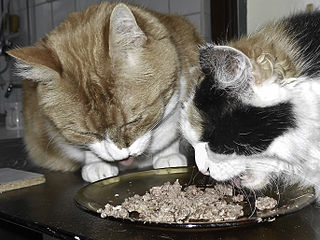Thiamine (vitamin B1) is an essential nutrient necessary for carbohydrate metabolism, muscle contraction, and nerve conduction. Very little thiamine is stored in the body and cats (as well as all animals) depend on a steady dietary source of the vitamin. Thiamine is naturally found in many food sources such as whole grain cereals, nuts, legumes, brewer’s yeast, and meat products, in particular in the skeletal muscle, liver, heart, and kidneys. Improper food storage and processing, consumption of uncooked fish that contain the enzyme thiaminase, and consumption of diets with sulfur dioxide or sulfite meat preservatives can lead to insufficient dietary thiamine. After two to four weeks of a thiamine deficient diet, cats exhibit salivation, anorexia (loss of appetite), and sometimes vomiting. If the deficiency is not corrected, then dilated pupils, bradycardia (slow heart rate), aggression, and progressive neurological symptoms such as ataxia (loss of coordination), rigid head and neck ventroflexion, twitching, loss of righting reflexes, seizures, coma, and death will ensue. Rigid head and neck ventroflexion is the most common clinical sign in cats presented to veterinarians.
Researchers at the Cummings School of Veterinary Medicine at Tufts University noted that five U.S. Food and Drug Administration voluntary recalls of commercial cat foods due to low levels of thiamine have been made in the past five years. This prompted them to measure thiamine concentration in commercial canned cat foods and determine effects of flavor (fish vs. moonfish), texture (‘pate’ vs. ‘non-pate’), country of manufacture, and company size on thiamine concentration. An additional low thiamine level recall was made during the publication process, bringing the total number of recalls to six in the past five years. The researchers analyzed 90 non-therapeutic canned cat foods (one fish and one non-fish flavor) from 45 brands.
Thiamine levels were below minimum requirement set by the Association of American Feed Control Officials in 12 of 90 (13.3%) foods and below minimum recommended allowance of the National Research Council in 14 of 90 (15.6%) foods. ‘Pate’ foods had significantly lower thiamine level than ‘non-pate’ foods, and smaller companies (less than $1,000,000 in retail sales) had significantly lower thiamine levels than larger companies (more than $2,000,000 retail in sales). Neither fish or non-fish flavor nor country of manufacture had a significant effect on thiamine level. Thiamine concentrations were found over a wide range in the foods evaluated. The researchers concluded that pet food companies should strive to measure and limit thiamine loss during processing and implement strict quality control practices. In addition, veterinarians should consider thiamine deficiency in cats presenting with acute neurologic dysfunction, especially with accompanying gastrointestinal signs.